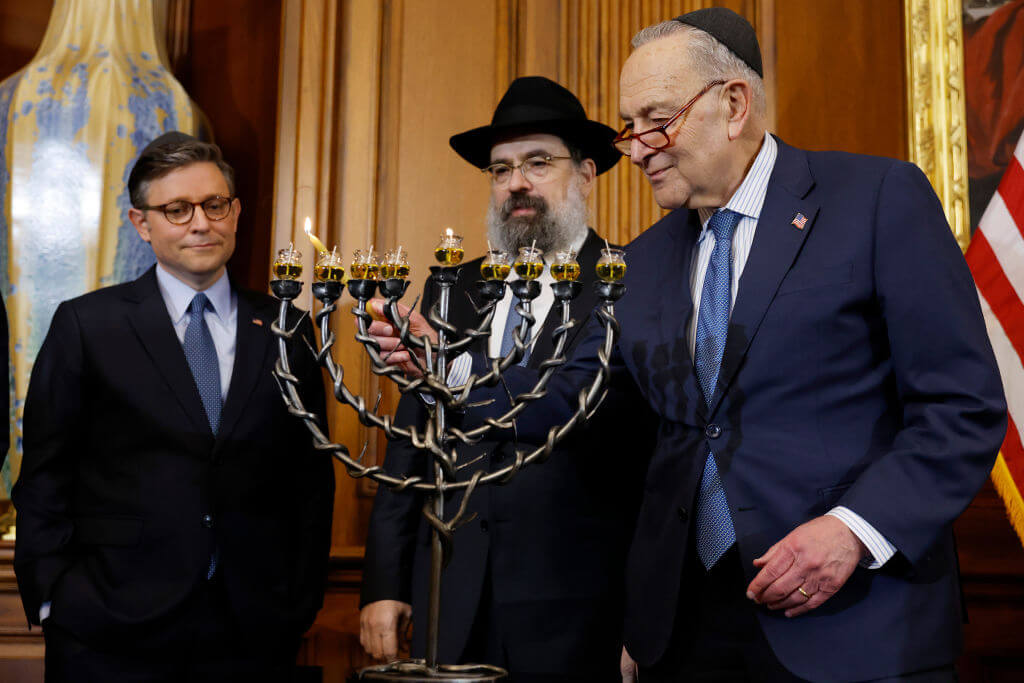A New Mixed Marriage?
A few weeks ago, my wife and I attended a wedding in Israel — the exact ambience of which I couldn’t put a finger on. The bride and groom and their families both came from what is known in Hebrew as the dati-le’umi — the “national religious” community — the closest American Jewish equivalent of which might be “modern Orthodox.” These are observant Jews who identify with the state of Israel, consider themselves Zionists, serve in the Israeli army (the boys, that is; the girls do alternative public service), wear “ordinary” clothing (plus knitted skullcaps for the men and sometimes kerchiefs or hats for the women), and are well integrated in Israeli life and society. They are definitely not h.aredim or “ultra-Orthodox.”
But this particular wedding had a strong haredi flavor. Many of the women were wearing sheytls, the wigs commonly used by the ultra-Orthodox, in place of kerchiefs or hats, to obey the injunction to cover a married woman’s hair. A large number of men wore black hats or yarmulkes in the ultra-Orthodox fashion and had their tsitsiyot — their ritual fringes — hanging out of their shirts. The wedding music as the bride was led to the canopy was sadder and more subdued than it is at “national-religious” weddings, and the men and women were seated at separate tables, something I had never seen at a “national-religious” wedding before. I turned to someone at my table and said: “Tell me, what’s going on here? Anthropologically speaking, I don’t know what I’m looking at.”
“What you’re looking at,” the answer was, “is a h.ardal wedding.”
Hardal was a word that was new to me. Or rather, it was a commonplace word, meaning “mustard” in Hebrew, and made no sense when applied to a wedding.
“What, apart from a sandwich spread, is a h.ardal?” I asked.
“It’s short for a h.aredi-dati-le’umi,” my informant said.
Several days later, I came across the word again, this time in a Hebrew newspaper. The context was an article about the so-called “hilltop youth,” the young religious settlers who have been in the news lately because of the “illegal” Jewish outposts that they have established in many parts of the West Bank. According to a recent sociological study, the article said, these settlers combined “national-religious” and “ultra-Orthodox” attitudes toward the land and the state of Israel in curious ways. On the one hand, typical of the “national-religious” community, they were territorial maximalists who believed not only in the Jewish right to all of Eretz-Israel, but also in the obligation to use Jewish power and military force to implement it. On the other hand, typical of the “ultra-Orthodox” community, many of them denied the validity of a secular Jewish state and said that they felt no allegiance to it. Fifty-three percent identified themselves as h.ardali — that is, as neither “national-religious” nor “ultra-Orthodox” Jews but as a fusion of the two.
This is the rare case of a new word signaling the emergence of a new sociological category. Until now, Israelis have divided their society into four socio-religious (or socio-irreligious) groups: h.aredi; dati-le’umi, also known simply as dati; mesorti or “traditional,” a term embracing what Americans would call Conservative and Reform Jews, i.e. — Jews who selectively observe certain religious customs and ceremonies but not others; and h.iloni or “secular” Jews who are totally nonobservant. Now we have a fifth kind of Jew, the h.ardal — the highly nationalistic ultra-Orthodox one who is more extreme religiously than the dati-le’umi Jew and more extreme politically than the h.aredi Jew.
Dati-le’umi. “National religious,” from which the dal of h.ardal is formed, became the term for a modern Orthodox Israeli because of the National Religious Party — the Miflagah Datit-Le’umit in Hebrew, generally known by its acronym of Mafdal. The only self-declaredly Zionist party among the four religious parties in Israel’s Knesset, the NRP grew out of its predecessor, the Mizrachi Party, founded in 1902 by several leading Orthodox rabbis in Eastern Europe. Defying the anti-Zionism of the Orthodox establishment of those days, which held that God and the Messiah alone could restore the Jews to their homeland, these rabbis declared themselves in favor of “a Hebrew state in the Hebrew land,” on the condition that it remain true to the Torah.
The emergence of the h.ardal is the product of the convergence of two different trends in Israeli religious life. The stronger of the two is the “haredization” of a generation of young “national-religious” Jews who have come to view the norms of ultra-Orthodoxy as a more authentic form of Judaism than that practiced by their parents. The second trend is the “Zionization” of parts of the haredi community, which have become much more nationalistic than they were in the past. As viewed by some, the h.ardalim represent the best of both worlds: the uncompromising commitment to tradition of the h.aredim and to Jewish militancy of the dati’im-le’umi’im. As viewed by others, they represent the worst: the extremism of hyper-religiosity joined to the extremism of hyper-patriotism. In either case, they are more mustard on the multi-decker sandwich of Israeli religious life.






















